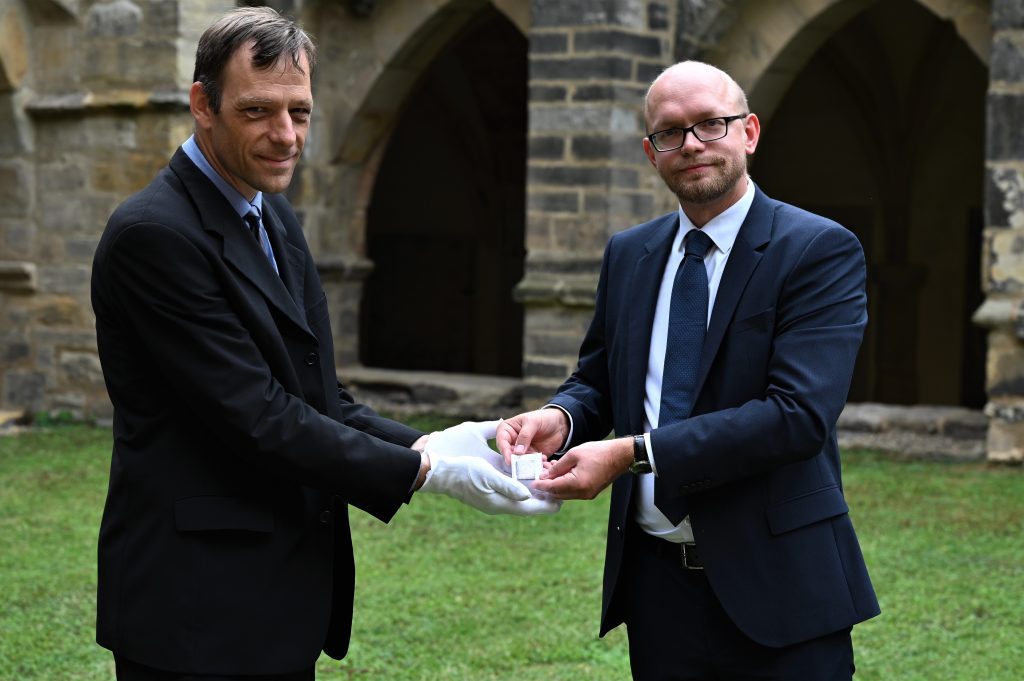"The clippe is an exhibit that brings history to life," said Roland Trampe, an employee of the Künker auction house, at the handover of a silver cliff from 1547 today in the cloister of Merseburg Cathedral.
In this threat of war, the Merseburg cathedral chapter, which was presided over by a Protestant bishop and an administrator, saw the cathedral treasury in danger. So they hurriedly had it transferred to Leipzig, to the care of the patron prince, Duke Moritz of Saxony. Leipzig was besieged by electoral troops during the war, but they withdrew after three weeks without success. Duke Moritz's troops in the city now had to be paid and open mutinies broke out. Duke Moritz then had the Merseburg Cathedral treasures stored in Leipzig melted down and minted in the cellar of Leipzig Town Hall. The precious metals were separated and processed into plates. Rough, mostly diamond-shaped pieces were cut out of these with scissors and embossed on one side. These coins are known as cliffs. The original embossing die, which was produced by the die cutter Steffan Steinbehr, has survived to this day. preserved in the Leipzig City History Museum. The coins were produced under great time pressure. Nevertheless, precise information on the amount of metal minted has been preserved. Around two and a half kilograms of fine gold were recovered.
However, the Merseburg cathedral treasures were irretrievably lost, even though the cathedral chapter intervened several times with Duke Moritz. To make matters worse, the larger parts of the cathedral treasury that remained in Merseburg had also been looted. Electoral troops had occupied the episcopal city of Merseburg on their march to Leipzig and carried away parts of the treasure remaining here. These were also minted. After those warlike events, the Merseburg Cathedral treasure was only a shadow of its former self. The coins were scattered throughout the empire by the colourful composition of the mercenary army.
(Markus Cottin, Director of the Merseburg Cathedral Abbey Archive and Library, and Roland Trampe, employee of the Künker auction house, at the handover of the cliff on 25 August 2022)
Thanks to a private tip-off, the Vereinigte Domstifter have now been able to purchase such a one-sided silver emergency clasp for a thaler from 1547 at an auction organised by the Künker auction house in Osnabrück. The object was estimated at 1,000 euros, but was only knocked down after a small bidding war. The sum of EUR 5250 was raised with the help of donors, such as the Eißner family from Merseburg, but especially the auction house itself. Roland Trampe, employee of the Künker auction house: "Our senior partner Fritz Rudolf Künker was made aware of the importance of the silver emergency cliff for the Merseburg Cathedral Treasure and immediately agreed to support the purchase of this piece for the Vereinigte Domstifter with €2,500. This is in keeping with the traditions of our auction house, as we have already supported many museums in the new federal states and Berlin in the past and see it as our duty to contribute to the return of important coins to the respective museums."
"Merseburg Cathedral is thus receiving an object for its collections that can provide an impressive account of the fate of the cathedral treasury in the age of the Reformation. Together with the preserved remains of the Merseburg Cathedral treasury, the cliff will now be on permanent display in the treasury in Merseburg's south cloister," emphasised Markus Cottin, Head of the Merseburg Cathedral Abbey Archive.
The Vereinigte Domstifter would like to thank all those involved and are delighted about the cultural enrichment of the historical landscape in southern Saxony-Anhalt associated with the acquisition.

